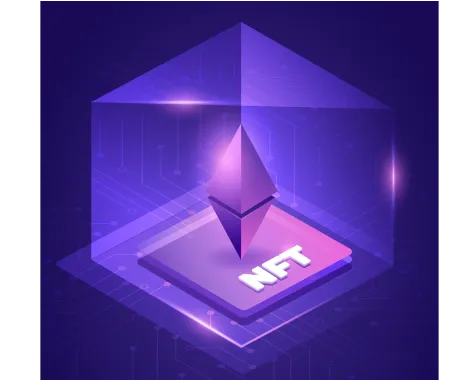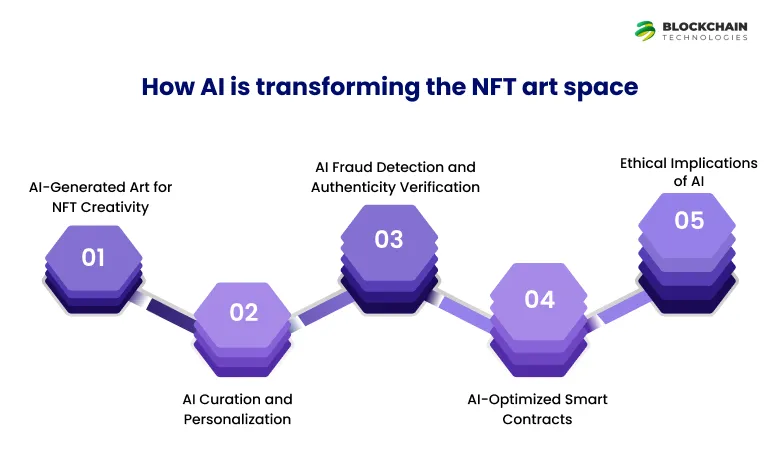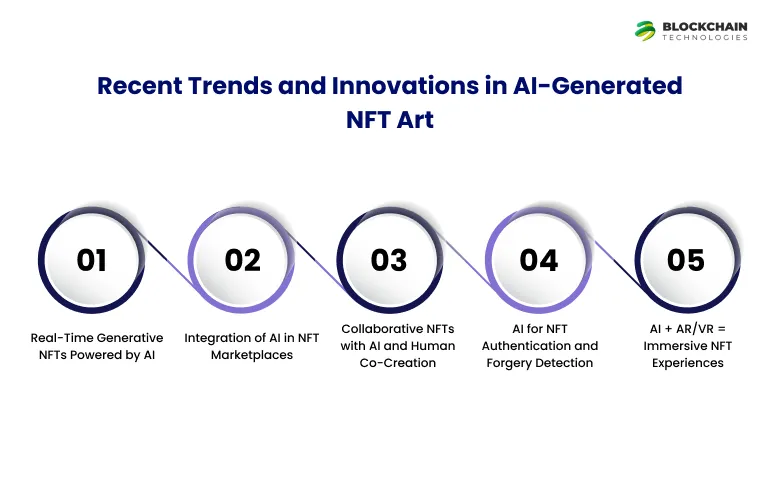The AI-NFT Fusion: Redefining Creativity in the Digital Art World
May 20,2025

The AI-NFT Fusion: Redefining Creativity in the Digital Art World
The digital art world is in constant flux, and the advent of Non-Fungible Tokens (NFTs) has already revolutionized how art is created, owned, and traded. But 2025 has brought a bold new frontier into focus: the AI-NFT fusion. This powerful synergy between artificial intelligence and blockchain-backed ownership is rewriting the rules of artistic expression, digital ownership, and how creators monetize their work.
According to recent projections, AI-generated NFTs are expected to contribute over $18 billion to the global NFT marketplaces by the end of 2025, with AI-generated art accounting for nearly 30% of new digital collections. Platforms that blend generative AI in NFT art with smart NFT tools are seeing record adoption among creators and collectors.
Welcome to the future of AI-powered NFTs, where Creative AI meets blockchain to form AI NFTs, a game-changing combination that’s making digital more dynamic, scalable, and personal. Whether you’re a seasoned artist or a tech-curious newcomer, a Blockchain development company like Blockchaintechs.io is now unlocking infinite creative possibilities.
What are AI NFTs and How Are They Created?
AI NFTs are blockchain-based digital assets that are created, curated, or enhanced using artificial intelligence. These assets range from static images and audio to dynamic, interactive experiences. What sets them apart is their fusion of algorithm-driven creativity and immutable digital ownership via NFTs.
Understanding the Technology Behind AI NFTs
To understand how AI is used to create NFTs is not as critical as we think. AI NFTs are more than digital files; they are intelligent, evolving expressions of human-machine collaboration. With generative AI in NFT art, creators are exploring a whole new language of creativity, one that’s decentralized, algorithmic, and deeply personal.
Core Components That Define AI NFT Architecture:

1. Generative Algorithms Drive the Art
- Generative art NFTs rely on AI models like GANs (Generative Adversarial Networks) and VAEs (Variational Autoencoders) that create art from scratch or evolve it based on specific styles or datasets.
- Artists input themes, moods, or parameters, and AI digital art tools generate unique, unpredictable creations.
2. Blockchain Secures Ownership
These AI-generated creations are minted into NFTs using blockchain smart contracts. Ownership, origin, and metadata (like the AI model used) are stored immutably, ensuring transparency and provenance in blockchain development art.
3. Dynamic and Interactive Capabilities
Some AI NFTs are coded to change over time based on user interaction or real-world data (weather, stock prices, etc.). This opens the door for AI-powered generative art platforms for NFTs to create art that evolves with its owner.
4. Metadata + AI Integration
The NFT file not only includes the visual or audio asset but also embeds key details like AI model configuration, dataset, and prompt. This offers a more complete picture of how AI is used to create NFTs and validates artistic contributions by both human and machine.
5. Smart Contracts
These blockchain protocols ensure each AI NFT is unique, tradable, and immutable. For dynamic pieces, contracts pull real-time data via Chainlink oracles to alter artwork (e.g., weather-driven color shifts).
Create. Code. Collect.
AI and NFTs are merging to unleash the next evolution in digital artistry.
How AI is transforming the NFT art space
Welcome to the era where code meets canvas, where Artificial Intelligence is a co-creator of breathtaking digital masterpieces. As tools like GANs and predictive analytics evolve, the line between human and machine creativity will blur further, raising both excitement and ethical questions.
Platforms like Artbreeder, Runway ML, and DALL·E 3 are empowering artists to unlock styles, moods, and visuals never imagined before. Just feed a prompt, tweak a few parameters, and voila, your next masterpiece is born from machine-driven magic. These stunning AI-generated artworks are then minted into NFTs, turning imaginative pixels into blockchain-certified digital assets, ready to be traded, showcased, and owned.

1. AI-Generated Art for NFT Creativity
AI is pushing the boundaries of artistic expression by enabling algorithmic art generation, democratizing creation for both coders and traditional artists. Generative Adversarial Networks (GANs) like Art Blocks use on-chain algorithms to produce infinite NFT variations from a single codebase. Top AI tools for NFT art creation like platforms DeepDream and *DALL-E 2* allow artists to mint AI-generated NFTs by inputting text prompts or style parameters. Customization layers let collectors influence outputs (e.g., adjusting color palettes or shapes) before minting, blending human-AI collaboration.
- Stable Diffusion models optimize computational efficiency, reducing GPU costs for rendering high-resolution NFT art.
- Hash-linking metadata ensures AI-generated NFTs retain provenance data, critical for verifying authenticity on blockchains like Ethereum.
- Royalty mechanisms embedded in smart contracts automatically compensate artists when AI-generated NFTs are resold.
2. AI Curation and Personalization
NFT platforms leverage machine learning to enhance user experiences, from discovery to investment. Behavioral analytics track user interactions (e.g., clicks, bids) to recommend NFTs using collaborative filtering algorithms. Platforms like OpenSea and Rarible use neural networks to predict trending art styles or collectibles. Sentiment analysis tools scan social media (Twitter, Discord) to identify hype around specific NFT projects. Dynamic Pricing Models
- AI-driven valuation tools analyze historical sales data, rarity traits, and creator reputation to estimate NFT floor prices.
- Liquidity optimization algorithms help sellers time listings based on market volatility, maximizing profits.
3. AI Fraud Detection and Authenticity Verification
Counterfeit NFTs and plagiarism plague the space, but AI-powered solutions are stepping in with Metadata and Image Analysis. Convolutional Neural Networks (CNNs) scan NFT images to detect duplicates or manipulated pixels, flagging potential fakes by authenticating NFTs with AI. Tools like SnifflesNFT use digital fingerprinting to verify artwork originality across platforms.
- Blockchain Anomaly Detection with predictive analytics identify suspicious wallet activity (e.g., wash trading) by analyzing transaction patterns on chains like Solana or Polygon.
- Smart contract auditors like CertiK employ AI to detect vulnerabilities in NFT minting contracts before launch.
4. AI-Optimized Smart Contracts
Smart contracts development are becoming smarter with AI integration, automating complex workflows. Oracles like Chainlink feed real-world data (e.g., weather, stock prices) into AI models to trigger dynamic NFT behavior. Automated Royalty Distribution with Natural Language Processing (NLP) parses licensing terms embedded in NFT metadata to automate royalty splits between collaborators. Example: An NFT artwork changes its visual theme based on live weather data fed via an oracle.
5. Ethical Implications of AI
While AI unlocks opportunities, it raises debates around originality, bias, and sustainability. Who owns AI-generated art: the coder, the AI, or the prompt writer? Legal frameworks lag behind technology. Training large AI models (e.g., GPT-4) consumes massive energy, conflicting with Ethereum’s shift to proof-of-stake for sustainability. Projects like Async Art use provably unique hashes to distinguish AI-assisted works from direct copies.
Ready to explore AI-powered NFT creation?
Discover the top AI tools for generative art and unleash your creativity in the blockchain art revolution!
What are the benefits of AI in NFT creation?
By 2025, AI-generated NFT art has surged from niche experimentation to mainstream adoption, fueled by advancements in generative AI, blockchain scalability, and shifts in digital ownership culture. Artists, collectors, and platforms like NFT ticketing are embracing this synergy for its efficiency, uniqueness, and profit potential. Here’s a breakdown of the technical, economic, and cultural forces propelling this trend.

1. Advancements in Multimodal AI Art Tools
Next-gen AI models now merge text, image, and code inputs to create hyper-personalized NFT art. Multimodal AI models like *DALL-E 4* and MidJourney v6 generate 4K-resolution NFT art from abstract prompts, reducing reliance on manual design skills.
Real-time rendering engines (e.g., Unity AI) let artists iterate AI outputs in VR/AR environments, minting immersive 3D NFTs directly to chains like Solana NFT Marketplace or Flow. Explainable AI (XAI) tools demystify how algorithms create art, building trust with collectors wary of “black box” processes.
Integration with Web3 Ecosystems:
- Decentralized storage networks (IPFS, Arweave) host AI-generated art metadata permanently, avoiding centralized server risks.
- Cross-chain interoperability protocols (Polkadot, Cosmos) let AI NFTs migrate between Ethereum, Binance Smart Chain, and gaming metaverses.
- Tokenized ownership models enable fractionalized AI art investments, lowering entry barriers for small collectors.
2. Cost Efficiency and Scalability
AI slashes the time and money needed to create, mint, and trade NFTs. No-code AI platforms (e.g., Runway ML) allow hobbyists to generate NFT art without coding, expanding the creator economy. Cloud-based GPU clusters (AWS, Google Cloud) cut rendering costs by 70%, making high-quality AI art accessible to indie artists. Layer-2 blockchain solutions (Polygon, Arbitrum) reduce gas fees for minting AI NFTs, enabling bulk drops.
Automated Market Strategies
- AI-powered NFT generators analyze trending styles (e.g., cyberpunk, abstract) to produce collections optimized for virality.
- Dynamic pricing bots adjust NFT auction reserves in real-time based on demand signals from platforms like Foundation or SuperRare.
3. Community-Driven AI Art Curation and DAOs
Decentralized communities now shape AI art trends through collective governance.Decentralized autonomous organizations (DAOs) like FlamingoDAO vote on AI-generated NFT acquisitions, blending crowd wisdom with algorithmic insights. Collaborative AI-art platforms (e.g., Artiva) let communities co-create NFTs by pooling prompts or training shared models. Gamified NFT ecosystems reward users for contributing data to improve AI generators (e.g., labeling art styles for model training).
Social Token Incentives
- Artists issue creator coins tied to AI NFT sales, allowing fans to share in revenue as models improve.
- Staking mechanisms let collectors earn yields by locking AI NFTs in liquidity pools on platforms like Uniswap V4.
4. AI-Resolved Intellectual Property (IP) Frameworks
Blockchain development and AI now tackle long-standing IP disputes in digital art innovation. NFT metadata standards (ERC-721, ERC-4907) embed AI training data sources, ensuring transparency for ethically sourced models. Smart contract auditors (e.g., OpenZeppelin) use AI to detect plagiarism in generative art code before minting.
Dynamic Royalty Models
- AI royalty trackers scan secondary markets to enforce splits between artists, coders, and dataset providers.
- CC0 (Creative Commons Zero) licensing gains traction for AI art, encouraging remix culture while on-chain registries track derivatives.
5. Sustainability Innovations
Critics once slammed AI and NFTs for high carbon footprints.with energy-efficient AI training. Sparse neural networks reduce energy use by 50% in models like Stable Diffusion 3, trained on renewable-powered cloud servers. Carbon-negative NFT platforms (e.g., KlimaDAO) offset emissions via tokenized carbon credits tied to AI art sales.
Green Blockchain Synergies
- Eco-friendly blockchain networks (Algorand, Tezos) dominate AI NFT minting, using proof-of-stake consensus to cut energy use by 99%.
- Recyclable AI models let artists retrain existing algorithms instead of building new ones, minimizing e-waste.
Real-World Use Case of AI-Generated NFTs in Digital Art and Ownership Transformation
1. Refik Anadol x MoMA (Museum of Modern Art)
Use Case: AI-Generated Data Paintings as NFTs
Turkish-American media artist Refik Anadol collaborated with MoMA to create a groundbreaking exhibition called “Unsupervised”, a collection of AI-generated visuals trained on MoMA’s vast digital archives. Anadol used advanced GANs to create mesmerizing, constantly evolving visualizations based on 200 years of art history.
NFT Integration:
Select pieces from the installation were turned into NFTs, allowing digital ownership of AI-interpreted artworks. This project marked a milestone in institutional acceptance of AI-generated NFT art, blending museum-grade curation with blockchain-backed ownership.
2. Christie’s x “Edmond de Belamy”
Use Case: First AI Art NFT to be Auctioned
Christie’s Auction House made headlines by auctioning “Edmond de Belamy”, an AI-generated portrait created by French art collective Obvious. The portrait was generated using a GAN model trained on 15,000 portraits from the 14th to 20th centuries.
NFT Integration:
The digital artwork was minted as an NFT and sold for $432,500, demonstrating early commercial validation of AI in fine art. This event catalyzed broader interest in AI-created NFTs across the traditional art and tech worlds.
3. Nike x RTFKT Studios
Use Case: AI-Generated Fashion NFTs.
After acquiring RTFKT Studios, Nike entered the Web3 space by launching AI-generated sneaker NFTs known as “Cryptokicks iRL”. RTFKT uses AI to create dynamic sneaker designs that evolve with user behavior or game interaction.
NFT Integration:
These designs are minted as interactive NFTs and paired with real-world sneaker drops. Nike positioned itself as a leader in merging AI creativity, fashion, and NFT ownership, appealing to Gen Z and digital-native collectors.
Don't Miss the Next Revolution in Art!
The fusion of AI and NFTs is redefining creativity and ownership. Be part of this transformative movement.
Recent Trends and Innovations in AI-Generated NFT Art
The world of AI-generated NFT art is evolving rapidly, fueled by groundbreaking tools, expanding use cases, and increasing global adoption. Let’s dive into the most impactful recent trends and future of AI and NFTs in digital creativity.

Trend 1: Real-Time Generative NFTs Powered by AI
- One of the most exciting developments is the rise of real-time generative NFTs.
- These NFTs evolve based on user interaction or live data sources like social media trends, weather changes, or biometric data.
- Powered by AI algorithms and smart contracts, these NFTs remain dynamic and engaging over time.
Trend 2: Integration of AI in NFT Marketplaces
- NFT marketplaces using AI are becoming intelligent ecosystems. Marketplaces are integrating AI-powered recommendation engines, curation algorithms, and automated NFT creation wizards.
- This enables better discovery, faster minting, and a personalized experience for both creators and collectors.
- Platforms like OpenSea and Rarible are experimenting with embedded AI art generation modules.
Trend 3: Collaborative NFTs with AI and Human Co-Creation
- The trend of human-AI co-creation in NFTs is growing. Artists use AI to initiate a piece, then refine or finish it manually, blurring the line between machine-generated and human-made art.
- This fusion results in hybrid NFTs that combine the soul of a creator with the speed and complexity of AI.
- It’s fueling a new genre of digital expression that celebrates both man and machine.
Trend 4: AI for NFT Authentication and Forgery Detection
- With the surge in digital content, verifying authenticity has become critical.
- AI-driven verification systems are being built into NFT platforms.
- These systems detect forgeries by analyzing pixel structures, style signatures, and watermarking patterns.
- As a result, authenticating NFTs using AI is enhancing trust and transparency across the ecosystem.
Trend 5: AI + AR/VR = Immersive NFT Experiences
- The combination of AI-generated NFTs with AR/VR technologies is opening the door to immersive art worlds.
- Users can now interact with NFTs in virtual galleries or augmented environments.
- AI personalizes the experience, while AR/VR makes it feel tactile and engaging.
- This trend is paving the way for experiential NFTs that go beyond screens and into lived spaces.
Conclusion: Shaping the Future of Creativity with AI and NFT Development
The fusion of artificial intelligence with NFT development is more than a technological trend, it’s a creative revolution. From real-time generative assets to immersive AR/VR experiences, AI-generated NFTs are pushing the boundaries of how digital art is created, owned, and experienced with smart NFT tools, creative AI, AI-powered generative art platforms for NFTs. This blend of intelligent automation and blockchain-backed provenance is unlocking new dimensions of personalization, interactivity, and scalability.
For creators, collectors, and brands alike, now is the time to embrace this next-gen digital canvas. Whether you’re building AI-powered art collections or launching dynamic NFTs that evolve with user data, partnering with the right blockchain experts is critical.
At Blockchaintechs.io, a top blockchain development company, we specialize in cutting-edge Fractional NFT marketplace Development that fuses creative vision with secure, scalable tech. From generative art engines to smart contract integration and AI personalization, we help businesses and artists lead the digital frontier. The AI-NFT revolution is here. Let Blockchaintechs.io be your innovation partner in crafting the future of intelligent digital ownership.
Want to Explore the Boundaries of Digital Art?
AI is the ultimate collaborator, pushing the limits of what’s possible in the NFT world. Join the innovations! Unlock the potential of AI in your NFT projects!
FAQs
AI allows creators to experiment with endless styles, lowers the entry barrier for non-artists, and enables rapid production of unique, high-quality artwork.
Through automation, personalization, and dynamic creation. AI can generate, authenticate, and even curate art, making the NFT process more efficient and creative.
Some of the best tools include DALL-E, Runway ML, Artbreeder, Midjourney, and NightCafe. These tools assist in designing, generating, and refining digital art pieces for NFTs.
It varies based on tools, platforms, and minting fees. On average, creating and minting an AI NFT can cost anywhere from $20 to $200 depending on complexity and blockchain used.
You can partner with an affordable blockchain app development company like Blockchaintechs.io to get end-to-end support on smart contract development, NFT marketplace setup, and AI integrations.
